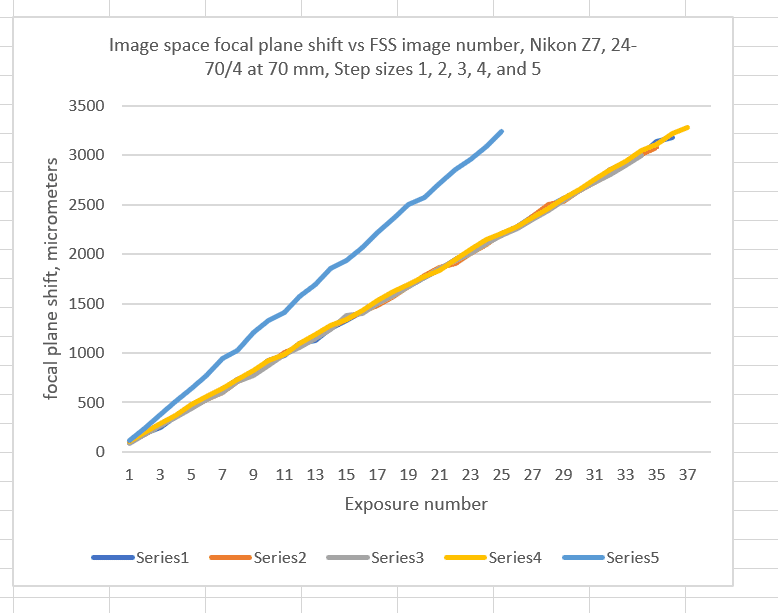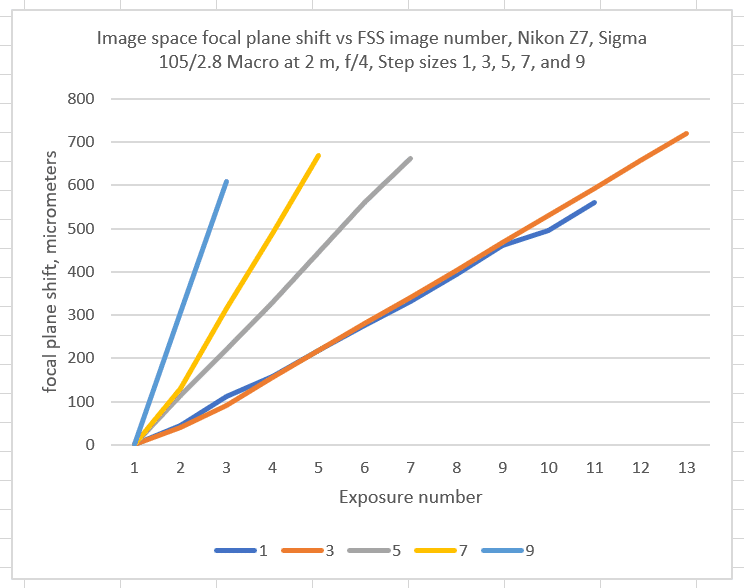This is one in a series of posts on the Nikon Z7. You should be able to find all the posts about that camera in the Category List on the right sidebar, below the Articles widget. There’s a drop-down menu there that you can use to get to all the posts in this series; just look for “Nikon Z6/7”.
I made a series of FSS exposures with the Nikon 24-70mm lens set to 70 mm, at f/4 with the step size set to 1, 2, 3, 4, and 5, and figured out the focus position in the image field, or, if you prefer, at the sensor plane.
The steps seem to be about the same size for step sizes of 1 through 4, and that step size is about 88 micrometers. The step size starts growing only at the 5 setting. The Z7 takes into account the lens aperture when it picks a step size. It doesn’t need to take the focal length of the lens and the subject distance into account because it works in the image field, not the object field. In the image field, the blur circle diameter is simply the amount of focal plane displacement divided by the f-stop.
The smallest step size expressed in terms of the size of the circle of confusion that results one step away from a perfectly-focused image is 22 micrometers. That is about 6 times the pixel pitch, which is pretty coarse, and even worse than the D850. I will need to do some more testing.
[Added 10/16/2018]
Here are results for the Sigma 105 mm f/2.8 macro lens at f/4 and at 2 meters:
It looks like the camera picked the wrong step size when set to 3.
Added 11/27/2023:
A reader measured with a faster lens and got the following for absolute lens position as reported by the camera in the EXIF. It’s not clear what the units are:
Width 5 = 53
Width 4 = 37
Width 3 = 32
Width 2 = 26
Width 1 = 18


Hi Jim,
I was wondering – does the CoC relationship hold for different focal lengths and apertures?
I really enjoy your site. Thanks for all the effort.
Best regards,
Mark
It does.
Thanks a lot Jim for your very interesting experiments on focus “shifting”.
What a strange implementation Nikon did for a mirrorless camera : you have to do it blindly ! A remainder of DSLR probably… Olympus and Panasonic are far ahead. Hopefully a firmware update will allow that. By the way, doing it hand held is perfectly feasible and leads to excellent results, see eg : https://fliesandflowers.blogspot.com
Thanks a lot Jim for testing this out in such a detail!
I am new to photo stacking and have a question. If the first focus point is set by the photographer and the number of shots taken is set, why do you also have to set the interval between the steps? Is this not a function of the number of photos and the starting point for focus on the sensor?
Best regards
Kjetil
The step distance is not a function of the number of shots and the starting point. The final plane of focus is a function of all three: the starting point, the number of shots, and the step size.
Ah, think I understand. Step size is not a distance on the sensor but out in the terrain?
A given step size is a constant distance at the focal plane, except that it varies with aperture. How that translates to distance in the object field depends on the focal length of the lens and the distance of the subject.
I am trying to understand how you got these graphs. You said, “the blur circle diameter is simply the amount of focal plane displacement divided by the f-stop.” How do you measure focal plane displacement? And more bothersome, how can i work backwards so that my last shot is at infinity (or at least within one CoC of infinity focus) to figure out what the closest in focus distance will be for the settings I pick (#of shots and step size)? Thank you for your work.
The focal plane displacement is the difference between the sharpest plane of focus and the sensor. I measure it in micrometers. It is measured along the lens axis, or perpendicular to the sensor plane.
I pick the closest focal plane first, decide on the step size, and do a trial run to see how many images it takes to get the focal plane as far away as it needs to be.